Looking back at Caption Generation ...
By Martin Kay, ZEN Computer Services (written for TV-Bay magazine, published Issue 22)
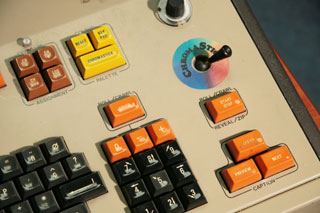 Back in the days before microprocessors, Character Generators were members of
the Graphics Department armed with sheets of Letraset and cardboard. The
finished caption cards were then handed over to the stage crew who acted as
"Caption Pullers". For a title caption sequence, cards were stacked in shooting
order alternately into two separate piles (like A/B film rolls) and placed on
blackboard-style easels somewhere in the studio. Two cameras (and cameramen)
would be assigned to shooting the captions, with the Vision Mixer switching
between them. As soon as the red light went out on the camera, the Caption
Puller would pull the top caption off the pile and the cameraman would frame up
on the one underneath.
Back in the days before microprocessors, Character Generators were members of
the Graphics Department armed with sheets of Letraset and cardboard. The
finished caption cards were then handed over to the stage crew who acted as
"Caption Pullers". For a title caption sequence, cards were stacked in shooting
order alternately into two separate piles (like A/B film rolls) and placed on
blackboard-style easels somewhere in the studio. Two cameras (and cameramen)
would be assigned to shooting the captions, with the Vision Mixer switching
between them. As soon as the red light went out on the camera, the Caption
Puller would pull the top caption off the pile and the cameraman would frame up
on the one underneath.
The more complicated captions were made as a multi-layer cardboard sandwich,
with holes in the front layer behind which cardboard tabs could be pulled out to
reveal additional text or images beneath. Each one had to be individually made
by hand and, with a few exceptions like the opening/closing station logo, could
rarely be used again. Worse still, any changes, or even a simple spelling
mistake, could mean the entire caption had to be remade. All in all, the whole
process was a potential recipe for disaster, not least from the simple action of
knocking a stack of precariously balanced captions onto the floor seconds before
they were needed.
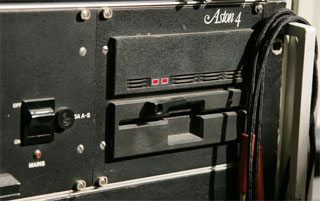 So itís not surprising that many production staff welcomed the arrival of
electronic caption generators with open arms - but not all of them did. You
might think that the Graphics people would be the first to celebrate the end of
rub-down lettering and cutting up cardboard, but it was not as simple as that.
Early electronic devices could knock out caption text in a fraction of the time,
with instant editing too, but where they gained in speed they lost heavily in
quality. Graphic designers take great pride in the detail of layout, from font
selection to the positioning of individual letters. For them, the lack of
proportional spacing combined with blocky or jagged-edged letters felt as much
like a return to the Stone Age as most of us now would feel if we had to go back
to the days without computers.
So itís not surprising that many production staff welcomed the arrival of
electronic caption generators with open arms - but not all of them did. You
might think that the Graphics people would be the first to celebrate the end of
rub-down lettering and cutting up cardboard, but it was not as simple as that.
Early electronic devices could knock out caption text in a fraction of the time,
with instant editing too, but where they gained in speed they lost heavily in
quality. Graphic designers take great pride in the detail of layout, from font
selection to the positioning of individual letters. For them, the lack of
proportional spacing combined with blocky or jagged-edged letters felt as much
like a return to the Stone Age as most of us now would feel if we had to go back
to the days without computers.
Things have moved on a long way to where we are now but, for many years in
between, one name became synonymous with electronic captions in UK television,
that of Aston. The Aston 3 & 4 dominated TV captions in the UK from their
introduction in the 1980s through into the '90s. Their combination of technical
quality and operational usability resulted in thousands of sales to over fifty
countries, and won the company a Queen's Award for export achievement in 1982.
Even today, for many people, any title overlay with a personís name and position
is an "Aston", just as any vacuum cleaner is a "Hoover" (or any edit suite an
"Avid").
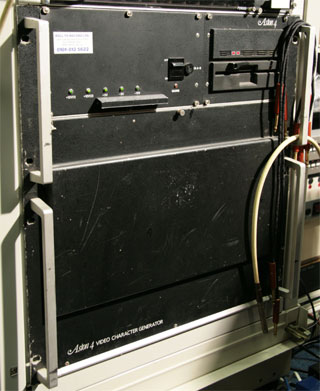 Astons were born into an era of studio design where equipment resources were
limited and centralization was the norm. Central VTR and Telecine areas assigned
machines to individual studios through a booking system, the theory being that
no one area would need continual access to these large and expensive machines.
It was all rather like the days of expensive mainframe computers before the
arrival of desktop PCs. Video and audio feeds were patched around the building
via tie-lines, and talkback systems used so that the studio could cue the VT
operator when needed. Aston CG machines had to be able to work in this way too,
kept in a central area and assigned to a studio or edit suite when needed.
Connecting the video output could be done just like a VTR, but operating the
Astons presented a different problem. For whereas the VT operator could be with
his machine in
the central area, it was less practical to give instructions and script changes
to a graphics operator who was not in the control room with the rest of the
production crew. As such, Aston developed a way of using standard video cabling
to allow communication between their dedicated keyboards and the central Aston
mainframe, itself a two foot high rack unit stuffed full of circuit boards.
Astons were born into an era of studio design where equipment resources were
limited and centralization was the norm. Central VTR and Telecine areas assigned
machines to individual studios through a booking system, the theory being that
no one area would need continual access to these large and expensive machines.
It was all rather like the days of expensive mainframe computers before the
arrival of desktop PCs. Video and audio feeds were patched around the building
via tie-lines, and talkback systems used so that the studio could cue the VT
operator when needed. Aston CG machines had to be able to work in this way too,
kept in a central area and assigned to a studio or edit suite when needed.
Connecting the video output could be done just like a VTR, but operating the
Astons presented a different problem. For whereas the VT operator could be with
his machine in
the central area, it was less practical to give instructions and script changes
to a graphics operator who was not in the control room with the rest of the
production crew. As such, Aston developed a way of using standard video cabling
to allow communication between their dedicated keyboards and the central Aston
mainframe, itself a two foot high rack unit stuffed full of circuit boards.
Aston operators would often bring the keyboard unit with them to a studio
control room, get it patched into the mainframe by the video engineers, and then
have to log-on in order to use it. They could also have a portable 5.25" floppy
disk unit, plugged into the keyboard, to allow the use of caption pages prepared
earlier and the addition of extra fonts to the system, without having to go off
and locate the actual mainframe itself in the bowels of central "racks". Despite
all this innovation, operating an Aston 4 at speed, particularly for a live
event, became something of a specialist skill, a bit like Steadicam but without
the kudos! If anything, you just got shouted at if you couldnít find the caption
with a playerís name fast enough after theyíd scored a goal (whilst
simultaneously remaking the caption with the score).
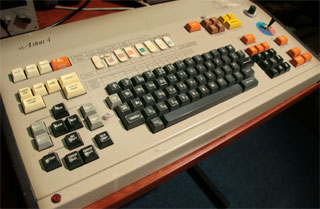 Everything on these Astons was keyboard driven, like using a PC under DOS. There
were additional dedicated function keys for tasks like line/letter
spacing/positioning, but you had to know what everything did - there was no
"on-screen help". Remember too, this was an age before the widespread use of
PCs, so very few people had any computer literacy skills to fall back on. I got
involved with Astons in the late '80s whilst I was at Granada TV (in film
sound). This was because they knew I could program on an Amiga, which had a nice
graphical user interface (for its day), and because the Aston had a serial port
through which it could be remote controlled.
Everything on these Astons was keyboard driven, like using a PC under DOS. There
were additional dedicated function keys for tasks like line/letter
spacing/positioning, but you had to know what everything did - there was no
"on-screen help". Remember too, this was an age before the widespread use of
PCs, so very few people had any computer literacy skills to fall back on. I got
involved with Astons in the late '80s whilst I was at Granada TV (in film
sound). This was because they knew I could program on an Amiga, which had a nice
graphical user interface (for its day), and because the Aston had a serial port
through which it could be remote controlled.
The initial project was to control an Aston 4 to produce a live countdown timer
for the Krypton Factor. After that was a more ambitious project for generating
snooker scores with statistics. All the operator would have to do would be click
on coloured balls on the Amiga screen when the players potted or fouled, and the
software would automatically update the score, maintain a "break" total, work
out the remaining points available, keep a log of the game, and update the Aston
with a current score caption including a graphical representation of how many
balls of each colour had been potted in the current break (once a certain
threshold had been reached). Unfortunately Granada immediately lost the snooker
contract before they'd used the software, but it was adopted by the new
operators and in conjunction with Wurmsers (thanks Neil!) it was used for ITVís
snooker coverage for several years in the early Ď90s. I still have an Amiga and
more recently bought an Aston to set up a little "technology museum" area, but
the keyboard doesnít work so I canít log on to the mainframe.
If anyone has an Aston 4 keyboard going spare, or can repair mine, Iíd love to hear from them!

" I've been a regular contributor to user groups and technical forums for the last 20 years or so, and have written hundreds of posts offering advice and information on a whole range of computer, audio & video production topics."Read some of them here... |




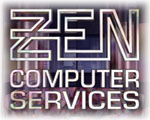

 Copyright ©
2010 Zen Computer Services.
Copyright ©
2010 Zen Computer Services.